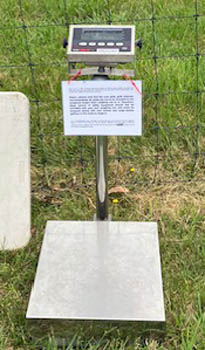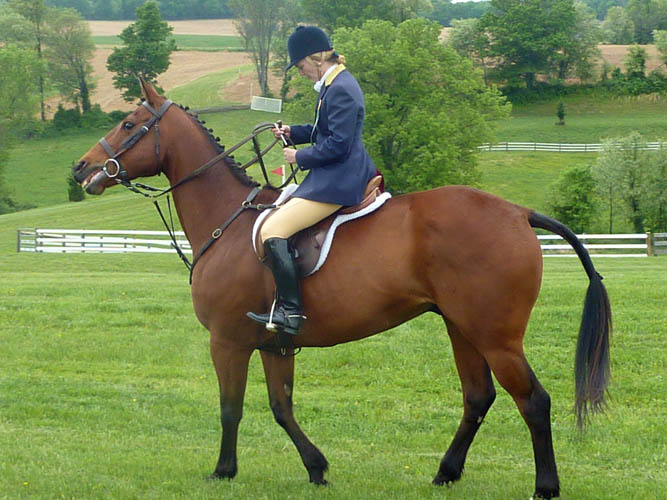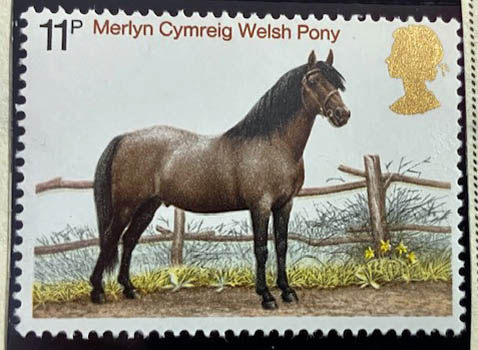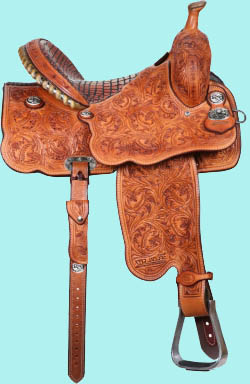Walk
[Equine Gait] The walk is the slowest of the three common natural gaits of horses: walk, trot, canter. A gallop might be said to be a fourth. It is the most frequent gait that a turned out horse will do on its own and requires the least energy. A rider impels a standing horse into a walk by easing pressure on the bit and gentle squeezing the horse's sides with both legs. A well-schooled horse should immediately begin a forward walk. Novices often forget to relax the hands and at the same time spread their legs and literally punch the horse in its sides with their boots. The horse is confused and unhappy with being punched as a result. This is what you call getting off to a very bad start and may end badly as well.
Walking the Course
[Jumping Competition] Prior to a jumping class the riders and their coaches may walk the course following the pattern that the jumps are ordered. This allows them to be familiar with the requirements of the course and plan accordingly.
Ware Hole
[Fox Chasing] "Ware Hole" is called by a hunter, who has spotted an animal hole in the area and warns riders not to let their horses step in the hole and potentially injure themselves.
Warm-Bloods
[Horse Breed Category] Warm blooded breeds are breeds said to be intermediary between hot-blooded (fast, energetic, flighty, relatively poor keepers) and cold-blooded (slower, even tempered, good keepers). Many of them have been used as dressage, military or sport horses.
Waterford Bit
[Equine Equipage] A Waterford bit is a snaffle with many small links rather than a solid mouthpiece. It is designed to discourage the horses from leaning or pulling on the reins. A tendency to pull on the reins regularly can be very annoying to the rider. However, it is possible the problem is more with the rider than with the horse. It might be as simple at the horse wants to go and the rider not. I have no experience with the Waterford and am uncertain how successful it might be to remedy the various causes of rein pulling, but I have heard a lot of testimonials. They are not allowed in dressage.
Weaving
[Equine Behavior] Weaving is a vice seen among some horses in which the animal repetitively moves its head and shifts its weight from side to side. This is common seen while standing in a stall.
Weigh Out

|
[Racing] Weight out is when a jockey is weighed by the clerk of scales prior to a race. The amount of weight carried by the horses in a race is the should be same with any difference made up by lead weights added to a saddle bag. If a jockey exceeds the assigned weight he can be disqualified. The minimum weight requirement for a jockey is typically 110 pounds. There is often a specified over weight allowance jockeys are permitted.
Well Turned Out (Turnout)

|
[Equestrian Comportment] A well turned out rider and horse arrive at an event approaching what an observer might consider an ideal appearance in terms of dress, grooming, appearance of tack, etc. As a mostly trail rider with riding clothing and tack that can only be called ancient, I do not believe anyone would call me well turned out. However, I do admire a well turned out rider when I see one.
Welsh Pony

|
[Equine Breed] Welsh ponies are a breed of small horses that are native to Wales. Those that exceed 42 inches in height are called Welsh Cobs rather than ponies. They have small heads with large eyes, are strong and generally even -tempered. They are used mostly as a children's mount or as a driving animal.
Western

|
[Riding Style] A popular style of riding emblematic of the American West and practiced by ranchers and cattlemen. The term is often used in contrast to the English riding style in North America. Western riding equipment and the manner of riding is distinct from other riding styles. An individual horse may be taught any style of riding but those practicing various styles often tend to favor certain breeds. Even though most people may wish to believe Western riding originated in the Western United States, in point of fact nearly all characteristics were developed by and imported from Mexican ranchers.
Weymouth Bit and Bridle
[Equine Equipage] The name Weymouth is given to both the complete bridle and also to the curb bit, one of two bits used on the bridle. The other bit is a snaffle, referred to as a bridoon.
Whinny
[Equine Vocalization] A whinny is the most familiar of the sounds that a horse can make. It is a rather long, high pitched "he-he-he" sound. A horse that sudden finds that it is alone in a field will whinny to locate and attract the attention of its herd mates. They will answer him. They will also whinny to humans as if it say, "Hey you, come down here and feed me." A whinny that is higher pitched, shorter and more urgent sounding can indicate distress. Like a mother can tell which of her children is crying, a horse owner knows, which of his horses is whinnying. I always investigate if I hear repeated whinnies coming from the horses. They do not whinny nearly as often as portrayed in movie sound tracts.
Whip
[Driving] The whip is the individual in the vehicle that is acting as the driver. By tradition whips are the first to enter and last to leave the vehicle. They may not even have an actual whip with them.
Whip Hand
[Driving] In driving the term whip hand generally indicates the right hand, while the term driving hand is the left hand.
Whipper-In
[Fox Chasing] The whipper-ins are members of the hunt staff or other designated hunt members (honorary whippers-in) who assist the huntsman in conducting the hunt and controlling the hounds.
Whiskers
[Surface Anatomical Term] Whiskers are the long hairs surrounding a horse's muzzle and function as a critical sense organ in a horses' day to day existence. Because horses are unable to see objects directly below their nose, these whiskers allow horses to feel rather than see in that space. Many horse organizations have issued statements against trimming them. The Fédération Équestre Internationale has outright banned trimming these whiskers, which had been common place grooming in the past.
Willingness
[Equine Characteristic] A horse is said to be willing if it willingly meets the expectations of its rider when faced with challenging training or adverse situations.
Winged Hussars

|
[Military] An elite branch of Polish cavalry originally light cavalry comprised of exiled Serbian warriors. Later they evolved into heavy cavalry units. An unusual feature of their dress was the large wooden frames worn in their backs to which feathers were attached. These created a sound when they advanced in a body and served to announce their arrival on the field. Historically, they were instrumental in lifting the 1683 siege of Vienna with the largest single cavalry charge in military history. Had Vienna fallen Islam would have dominated central Europe as well as the Balkans.
Winter Coat (Casting Coat - British Usage)
[Equine Physiology] Horses develop a longer, warmer winter coat during the winter and then shed it during the spring. Shedding is a function of the daily daylight rather than temperature.
Withers
[Equine Anatomy] The withers is a prominence at the beginning of a horse's back, located above and just behind the horse’s shoulders and formed by the 3rd to 11th long thoracic vertebrae. This is the highest stable point on a horse's profile, excluding the head and head, which might be raised or lowered. Horse's heights are measured to the withers as a reference point. Withers are also important in fitting and positioning a saddle, which should ride above the withers and not make contact with it.
Wolf Teeth
[Equine Anatomy] A wolf tooth is an unnecessary, vestigial premolar located in front of the cheek teeth in a horses month. They can interfere with the bit and should be removed, When they fail to fully erupt they are called blind wolf teeth. These are sensitive and cause problems with feeding. Wolf teeth should not be confused with canine teeth, which are located in a totally different place.
Wood Biting
[Equine Behavior] Wood biting or chewing is a vice, in which the horse repetitively bites wood fences, stall doors, etc. It can do considerable damage to a facility. There is still a fair amount of controversy regarding the best management strategy.